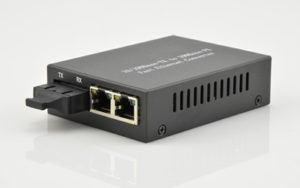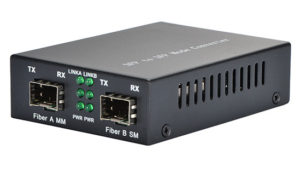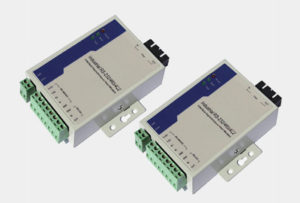With the expected growth of today’s communications, network operators must meet the continuing growth in data traffic and the increasing demand for bandwidth while making full use of the investment in the existing network infrastructure. Instead of costly upgrade and rewiring for fibers, fiber media converters provide a cost-effective solution by extending the life of the existing structured cabling. How fiber optic media converter can achieve this? And how much do you know about it? Today, this article will tell you something about fiber media converter.
Fiber media converter is a simple network device that can connect two different media types such as twisted pair with fiber optic cabling. Its function is to convert the electrical signal used in copper unshielded twisted pair (UTP) network cabling into light waves that used in fiber optic cabling. And fiber media converter can extend transmission distance over fiber up to 160 km.
As the fiber optic communication evolves quickly, fiber media converter offers a simple, flexible, and economical migration to future-proof fiber optic networks. Now it has been widely used in in-house areas, location interconnection and industrial applications.
Today’s converters support many different data communication protocols including Ethernet, PDH E1, RS232/RS422/RS485 as well as multiple cabling types such as twisted pair, multimode and single-mode fiber and single-strand fiber optics. And they are available with different designs in the market depending on the protocols. Copper-to-fiber media converter, fiber-to-fiber media converter and serial-to-fiber media converter are only part of them. Here is a brief introduction to these common types of fiber media converter.
When the distance between two network devices exceeds the transmission distance of copper cabling, fiber optic connectivity makes a big difference. In this case, copper-to-fiber conversion using media converters enables two network devices with copper ports to be connected over extended distances via fiber optic cabling.
Supporting the IEEE802.3, fiber to Ethernet media converter can provide connectivity for Ethernet, fast Ethernet, Gigabit and 10Gigabit Ethernet devices. And they can be used in a variety of networks and applications. The common types of this media converter are fast Ethernet media converter, Gigabit Ethernet media converter and 10 Gigabit Ethernet media converter.

Fiber-to-Fiber media converter can provide connections between single-mode and multimode fibers, and between dual fiber and single-mode fiber. Besides, they support conversion from one wavelength to another. This media converter enables long distance connection between different fiber networks.

Serial-to-fiber media converters allow RS232, RS422 or RS485 signals to be transmitted across a fiber optic link. They provide fiber extension for serial protocol copper connections. In addition, serial-to-fiber media converters can detect signal baud rate of connected full-duplex serial devices automatically. RS-485 fiber converters, RS-232 fiber converters and RS-422 fiber converters are the usual types of serial-to-fiber media converters.

We have got familiar with the common types of fiber media converters, but how to choose a suitable one is still not an easy work. Here are some simple tips on how to choose a satisfying fiber media converter.
- Make clear whether the chips of the fiber media converter support both half-duplex and full-duplex systems. Because if the media converter chips only support half-duplex system. It may cause serious data loss when it is installed to other different systems.
- Make clear which data rate you need. When you choose a fiber media converter, you need to match the speed of the converters on both ends. If you need both speeds, you can take dual rate media converters into consideration.
- Make clear whether the media converter is in line with standard IEEE802.3. If it doesn’t meet the standard, there will be compatibility issues absolutely, which can cause unnecessary problems for your work.
Fiber media converters play an important role in today’s multi-protocol, mixed media local area networks. And it is also a critical component of the data networks. A suitable fiber optic media converter can reduce the overall networking cost and extend transmission distance. Fiberstore provides a broad range of media conversion devices adapting to all kinds of working environments. Welcome to choose the ideal one for your networks.
Related Article: Fiber Media Converter: What Is It and How It Works?
